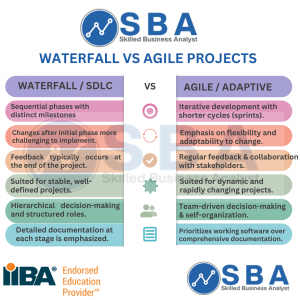
In order to effectively gather requirements, facilitate communication between stakeholders, and ensure that project goals are met Business Analysts need to understand the framework of the selected methodology that is being used in their organisation – Waterfall or Agile. This blog explores these two approaches in the world of project management. We’ll break down what makes Waterfall and Agile different, how teams work, and when it’s best to use each method.
Waterfall:
- Limited Interaction: Waterfall projects involve customer input primarily during the initial requirements gathering phase.
- Late-Stage Feedback: Customers typically see the product near the end of the project, limiting their ability to influence major changes.
- Fixed Scope: Waterfall projects often have a fixed scope, making it challenging to accommodate customer changes without significant delays.
- Distinct Phases: Customer involvement is concentrated at the start and end of the project, with minimal interaction during development phases.
- Risks of Misalignment: If customer needs evolve during the project, Waterfall may lead to a misaligned final product.
- Delayed Value: The product’s value is realized only at the end of the project, which might lead to surprises if customer expectations aren’t met.
Agile:
- Constant Interaction: Agile methodologies like Scrum and Kanban emphasize ongoing collaboration with customers throughout the project.
- Iterative Feedback: Customers are involved in each iteration, providing feedback that guides the development process.
- Adaptive Changes: Agile projects accommodate changing customer needs, ensuring the final product aligns with their evolving requirements.
- Shared Ownership: Customers become part of the project team, sharing responsibility for decisions and outcomes.
- Quick Adjustments: If customers’ priorities shift, Agile allows adjustments without derailing the project timeline.
- Early Value Delivery: Agile aims to deliver incremental value to customers with each iteration, allowing them to see tangible progress sooner.
If you are interested in learning more, please contact The Skilled Business Analyst for more information.
Yours in Analysis
Tendai
Business Analysis Instructor

